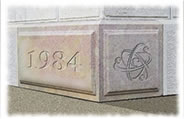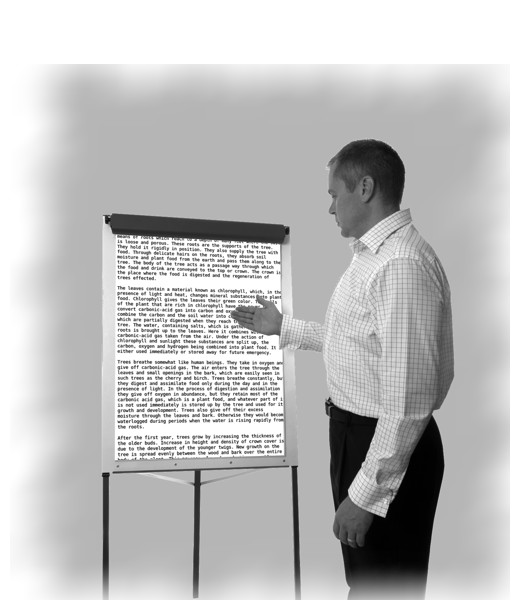If it Needs to be Read, it’s a “Reading Assignment”
The “Back to Basics” Series
“The word is about, there’s something evolving,
whatever may come, the world keeps revolving.
They say the next big thing is here,
that the revolution’s near,
but to me it seems quite clear
that it’s all just a little bit of history repeating.”
“History Repeating”
Performed by Dame Shirley Veronica Bassey, DBE
Welsh Popular Singer and Pop Icon
1937 –
Are you one of those people? Addicted to words? Just a little compulsive? Never enough documentation in your presentation? Inclined to add three more screens when five less would actually make your point? Listen up!
The Pocket Pico Projector is here! Paired with your Smart Phone, you can now bring the entire contents of the Encyclopedia Britannica to your next big screen presentation!
“We’ve seen it before…”
It’s been several decades and several “Revolutions in Conference Room Technology,” yet we fear the lesson has not yet dawned: “It’s not the technology upon which it is displayed, but the content itself that comprises a ‘visual aid,’ or not…” If the meaning is instantly obvious, it’s a “Visual Aid.” If it isn’t, well…
A Brief History of the Visual Aid
- Magic Lanterns, Newsreels and Movies
- Blackboards and Chalk
- Mimeograph Machines / Purple Printouts
- Flip Charts / Hand Drawn Displays
- Xerox Copiers
- Overhead Projectors / Orator Typeface
- Colored Transparencies / Slow Reveal Pens
- Slide Shows / Carousel Projectors
- Computers / PowerPoint
- Laser Printers / Graphics
- Portable Projectors (20 lbs?)
- Video Teleconferences
- iPads, etc.
They’re all helpful (or prosaic…) depending on how well they’re employed. But if this great new technology is merely an excuse for shrinking, implanting and displaying text in ever greater quantities, well, it’s not really a Visual Aid…
Are you one of those people? One of those for whom no amount of words is ever sufficient? Does the latest technology just serve as an excuse to feed the word-count beast? Or can you turn the corner with this new tech, and show us what you mean, instead of telling us about it?
Our suggestion: A complete presentation contains material tailored for and attractive to Text, Visual and Sense faculties. Though the mind has all three, the challenge for each of us, is that personally, we usually favor only one. Meaning that while we may love text, we leave the “picture” and “sense” people alone in their isolated corner. “Can I show you more text? How about a graph? And a tasty equation perhaps?”
If we love pictures, (think Apple…) then we show you a great slide show on a really big screen while ignoring the dress and deportment of that street person… oops, the Speaker…
If we are sense oriented, (think Cirque du Soleil…) we create dramatic or surprising emotional experiences, we use props, music, colors, great food… but we may leave the logic, plot and analysis lacking… “Wow! That was really entertaining! What was it about?”
With the advent of the Pocket-Sized Pico Projector and the iPhone, it’s easier than ever to overwhelm people with too much text or technology… Now’s your chance. But if you’ve ever wondered if you’ve stepped over the border into too much text land, here’s a quick guide:
- If it must be read, it’s a Reading Assignment… Verbal
- If it must be seen, it’s a Visual Aid… Visual
- If it must be experienced, it’s a Demonstration… Kinesthetic
We may all cling to our favorite style, but the combination of all three is a knockout! Don’t be confused by new technology — tell them, show them and help them experience the point!
Another new technology takes the world by storm, And let’s hope it’s not just a little bit of history repeating…
Applications
1. Personally
As you find yourself center-stage with a point to make, heed the age old performer/designer advisory: “Less is more” and take your text, your movement, your modulation and your visual content down to the minimum required to create the outcome you desire. Don’t put anything in because you like it, but only because it will do the job.
2. At Home
This is where we learn some bad habits. Communication styles tend to cluster in families, so we learn “What works!” and “What doesn’t!” from Parents and Siblings. But they may all be just like us. So they like what we like. By the time we get to school it’s “Us against Them;” and everyone else is just that — everyone else.
Take your clan out looking for things that are “out of the family envelope” and begin to savor the food, fun and communication styles that are normal for other people, but foreign to you. The family will thank you eventually, especially when you analytical types get to Rome and are not put off with the body language. There’s a whole world of custom, style and communication out there waiting to be appreciated — and none of it fits on a spreadsheet.
3. At Work
The French do it differently — communication. And the Italians “March to a Different Business Drummer.” In Bali, the pace is different – and the point. Canadians and Americans are cool and hotter — but both analytical. Keeping it all straight is a challenge. But isn’t it reasonable to make sure that every kind of communicator in the room has content focused on their tastes? At minimum, cover the basics with words, pictures and experiences.
And we’ve seen it before. And we’ll see it again — unless this time, we learn our lesson and tell, show and demonstrate.
Dessert Course:
The Legendary Shirley Bassey performs “History Repeating” with the Propellerheads…
Subscribe to our Newsletter


